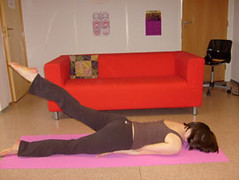
'Shalabha ' is the Sanskrit word for locust. 'Shalabhasana 'is so called because,while performing it, the body assumes a posture which resembles a locust.A practitioner of this asana will have to imitate a locust as it prepares to have its meal by lowering its head and raising its tail. When this asana is practiced with one leg, it is called 'Ardha shalabhasana'.
Technique :
- Lie on the stomach with the face down on the ground.
- Stretch both the arms beside the body and clench the fists lightly. The hands can also be placed under the thighs.
- Inhale and retain the breath till the completion of the asana.
- Pull the body and raise the either of the legs by about 30 cms off the ground. Raise the legs as high as possible.
- Stretch the soles of the feet.
- Hold this position for five to thirty seconds. Then slowly bring the leg down on the ground. Exhale very slowly.
- Repeat this exercise with the other leg. This asana can be repeated six to seven times.
Cautions :
- do not clench your fists too tight or too loose.
- Persons with hernia, weak lungs and cardiac complaints should not practice this asana.
- Pregnant women should also not practice this asana.
Benefits of this asana :
- As far as the spinal bend is concerned, this asana is inverse to Pashchimottasana. This asana gives twist backwards to the spine.
- Bhujangasana develops the half upper part of the trunk, while shalabhasana develops the remaining lower part of the trunk.
- It is very useful in extricating waste matter accumulated in the intestines.
- It gives good exercise to the abdomen. The kidney, the liver etc. become active.
- It cures constipation, gas troubles, indigestion, dysentery, acidity and other abdominal disorders.
- The practice of this asana counters tendencies to piles. It removes the arches of the soles of the feet and cures the disease of the appendix.
- It improves blood circulation.
- It dissolves excess fat from the thighs, hips, waist, abdomen and the posterior.
- Diabetic patient may practice this asana to control the disease.
- This yoga pose benefits women through its effect on the overies, uterus, helping to correct disorders of these organs.
- Various organs and glands like the reproductive organa as well as the adrenal and prostrate glands are activated.





No comments:
Post a Comment